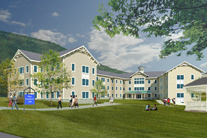Welcome to Erik's AE Senior Thesis e-Portfolio
Building Statistics
General Building Data: |
||
| Building Name: | Mount St. Mary’s - Student Housing Project | |
| Location: | Emmitsburg, MD | |
| Building Occupant Name: | Mount St. Mary’s University | |
| Occupancy: | Student Housing / Dormitory | |
| Size: | 60,000 SF | |
| Stories: | 3 Above Grade / 4 Total | |
| Primary Project Team: | Owner: Mount St. Mary’s University Architect: Ayers / Saint / Gross Architects Construction Manager: Gilbane Civil Engineer: Harris, Smariga, & Associates, Inc. Structural Engineer: Keast & Hood Co. MEP Engineer: Burdette, Koehler, Murphy, and Associates, Inc. |
|
| Construction Dates: | 2007 Completion Date | |
| Cost: | $10,800,000 Total / $3,400,000 MEP | |
| Delivery Method: | GMP | |
|
||
| Architecture: | ||
Design and Functional Components: |
||
This new student housing building is arranged to create the appearance of a village, complementing the entire campus and integrated by a pedestrian footpath that connects a new courtyard to the center of campus. The building is comprised primarily of 4-bedroom suites, each with a shared bathroom and living area. Small lounge areas are provided on each floor, and the ground floor includes a private residence for the hall director, a common lounge, and a central laundry facility. |
||
Major National Model Codes: |
||
IBC 2003 |
||
| Zoning: | ||
IBC Building Occupancy - Residential Group R-2 |
||
Building Envelope: |
||
|
Roofing System: | |
|
The roof is comprised of shop prefabricated wood trusses at 24” OC with 2x6 the minimum size for the top and bottom chords. An asphalt shingle roof over 5/8” plywood is then nailed to these trusses, and the typical 7:12 slopes end at 6” round gutters on adjustable brackets. The roof over the tower is made up of a folded copper seam over continuous 1x3 sheathing. | |
| Exterior Wall Systems: | ||
| The basement retaining walls are concrete with 5/8” foil faced gypsum board. The above ground floors are of typical construction, 2x6 or 2x8 wood studs faced on either side with 5/8” gypsum board and filled with R-19 batt insulation. At the stairwells, the wall construction changes to 8” CMU with horizontal reinforcing, R-10, 2” cavity board insulation, and 5/8” gypsum board. The wall construction for the tower is comprised of 2x4 wood studs at 16” OC and filled with R-19 batt insulation. The majority of the building’s windows are aluminum-framed single-hung windows with an operable lower sash, and a handful of fixed aluminum-framed windows are scattered throughout as well. The exterior veneer for the building is typically cement board siding with 6” exposures except for a stone veneer that wraps around the entire building and extends up from the ground approximately 4 feet. | ||
| Engineering Systems: | ||
| Structural System: | ||
| The building's foundation is composed of 1' spread footings and 5" concrete slabs resting atop 6" of crushed stone. Flooring above grade is made up of 1 1/2" of fibermesh concrete over 3/4" tounge-and-groove wood flooring. The floors are supported by wooden I-joists, and the bearing walls are 2x6 wooden stud walls in all locations with the exception of the interior stairwells, which are 8" CMU block. The roof is gabled with a slope of 30 degrees and is supported wooden 2x6 rafters. | ||
| Mechanical System: | ||
| The building's mechanical system has two major components: a dedicated outdoor air system utilizing energy recovery and a geothermal heating and cooling system. The ventilation system is composed of three 1050 CFM energy recovery units which provide tempered ventilation air to numerous water-source heat pumps located throughout the building. The heat pumps, which range in capacity from 12MBH to 30 MBH and are located in each suite and lounge area, then provide heating and cooling through the utilization of water being pumped through 125 geothermal wells located throughout the site. There is also a single 600MBH, 750 gallon domestic hot water heater, which serves the building's heated potable water requirements. | ||
| Electrical/Lighting System: | ||
| The building's electrical system is stepped down to 208Y/120V prior to entering the building by a transformer provided by the power company. This 3 phase current then runs to a single 1600V switchboard, which in turn feeds the other 14 panelboards throughout the building. The building's lighting system consists of various 120V fluorescent wall washers, ceiling-mounted pendants, and other conventional downlighting, and the emergency lighting is all on battery backup. | ||
